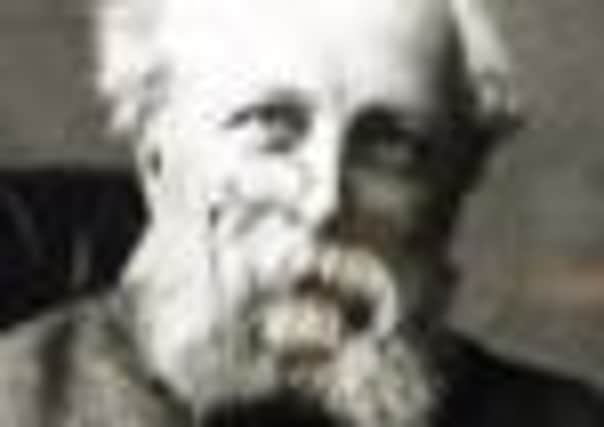Campaigners: Professor Heddle’s legacy ‘neglected’


But campaigners believe National Museum of Scotland (NMS) chiefs are neglecting the legacy of Professor Matthew Forster Heddle by keeping most of his collection, especially his agates, known as “Scotch pebbles,” in storage rather than on permanent display at the Edinburgh institution.
Members of the Scottish Mineral and Lapidary Club (SMLC), who will be holding their annual Heddle Night on Thursday – this year celebrating the 185th year anniversary of the Orkney-born academic’s birth – said visitors were often disappointed at how little of the collection is on show.
Advertisement
Hide AdRichard Gillanders, mineral curator of the Edinburgh-based club which is the oldest in Britain, described Heddle’s collection of agates as “second to none”.
“Matthew Heddle’s collection was the best and largest collection bequeathed to the museum,” Gillanders said.
“Years ago there were rows and rows of rocks on display.There have been a number of revamps at the museum over the years and our view is that with this most recent revamp there is hardly anything of Heddle and mineralogy on display. There are interpretation boards about the rocks but even that is not particularly well done.
“A lot of people from overseas want to see the best of Scotland’s collection and this isn’t happening at the moment. Some of our members say that when they have visited museums when they are abroad on holiday Heddle seems to get more attention than in Scotland.”
Heddle, who was born in 1828, lived in an era when there was a mania for collecting and categorising items ranging from gems and minerals to plants and meteorites for scientific research.
After an unhappy stint working as a doctor in the Grassmarket in Edinburgh, Heddle chartered a boat to the Faroes in 1856 and gathered a huge collection of stones and sold the duplicates to other collectors to lay the foundation for his own collection. He was known for his often less than subtle methods, carrying a 28lb sledgehammer and dynamite to gain access to hard-to-reach samples.
Advertisement
Hide AdHe went on to become a professor of chemistry at St Andrews University but devoted himself to collecting minerals, and eventually brought together more than 5,700 specimens.
Around the same time jewellery, such as plaid agate brooches and skean dhus decorated with Cairngorm smoky quartz crystal, Sutherland amethysts, green Isle of Rum bloodstone and Campsie Fells jasper, became the height of fashion.
Advertisement
Hide AdQueen Victoria was particularly fond of agate jewellery which she said epitomised the colours of the Highland landscape. But the market was eventually flooded by imports from abroad, leaving the original pieces highly sought after by international collectors.
Hollywood A-listers such as Jennifer Aniston, Courteney Cox and Jessica Alba have all been spotted sporting agate pendants. Fashion houses such as Chanel and Yves Saint Laurent have also sent models down the catwalk wearing the distinctively banded jewellery.
Councillor Steven Heddle, of Orkney Islands Council and a descendant of Heddle, said: “Speaking as a fellow Orcadian, scientist and Heddle, it has always been evident how well known Professor Heddle’s work is in its field, both nationally and internationally, even to this day.This should be celebrated and brought to a wider audience, or this significant Scottish contribution to world science in the Victorian age may end up diminished and forgotten.”
Alistir Tait, an Edinburgh jeweller with a special interest in Scottish agates and a member of the SMLC, described the Heddle collection as “amazing”. He said there was strong demand from overseas for old Scottish jewellery with agates and other stones.
“The museum has been very bad by only displaying a few minerals and not many Scottish ones,” he said. “They have changed the labelling system so they don’t say which collection specimens come from. Heddle’s family have been lobbying the museum about this.”
Mark Taylor, director of the Museums Association, defended NMS, saying museums had to perform a “balancing act”.
Advertisement
Hide AdHe added: “The National Museum of Scotland is designed to show Scotland to the world in all its glory, its physical, cultural and historical attributes. People want to know different things about different aspects and this can be difficult to balance.
“It is important that exhibits change to reflect people’s interests and concerns. It must also be pointed out that collections are a resource and not just for display. Specimens are used for research by specialists and many of these items will be digitalised and can be looked at that way.”
Advertisement
Hide AdA spokesman for National Museums Scotland said: “We fully recognise Professor Heddle’s position as a hugely significant figure in Scottish mineralogy. A large section of our website is dedicated to his life and collections. From there, visitors can also download a trail of specimens from his collection which can be found throughout the National Museum of Scotland.”
Twitter: @ScotsmanShanR